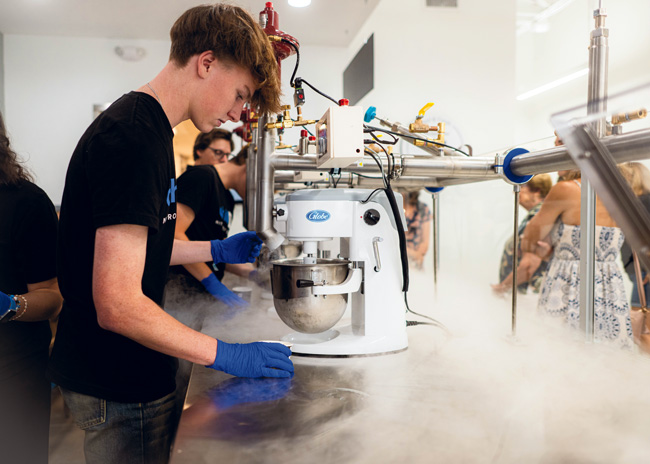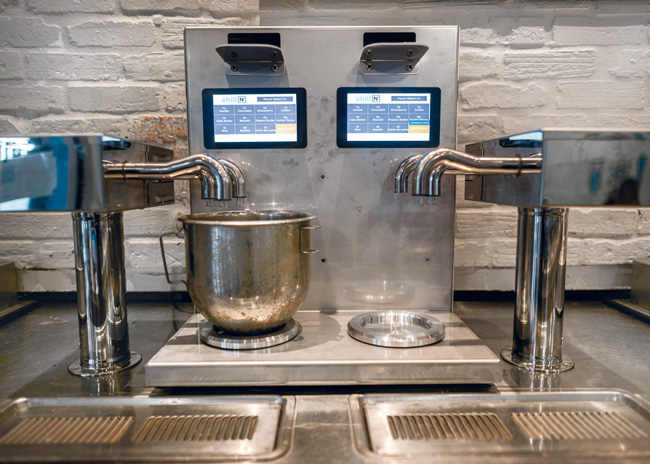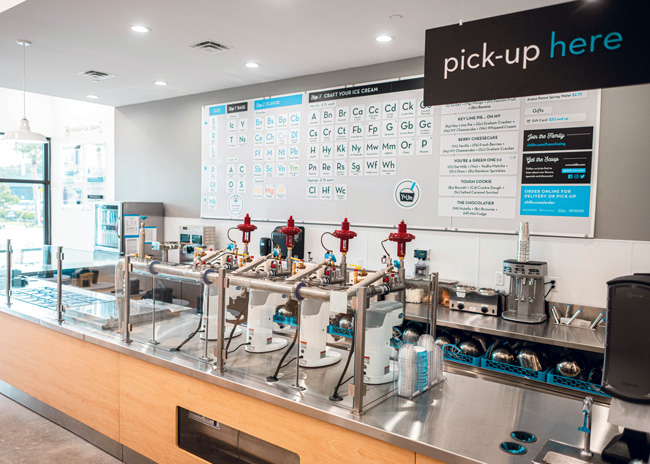By refining operations and infrastructure, this chain has cut build-out costs by 20% while increasing throughput.
 Chill-N starts with a base (usually cream) and mix-ins like fruit or candy, then instantly freezes them into ice cream using -320 degrees F liquid nitrogen.Danny Golik initially planned to take a year off between graduating college and starting medical school. Instead, he built a career based on some basic science and people’s love for a sweet treat.
Chill-N starts with a base (usually cream) and mix-ins like fruit or candy, then instantly freezes them into ice cream using -320 degrees F liquid nitrogen.Danny Golik initially planned to take a year off between graduating college and starting medical school. Instead, he built a career based on some basic science and people’s love for a sweet treat.
Golik is co-founder and chief operating officer of Florida-based Chill-N Nitrogen Ice Cream. This 14-unit concept makes each serving of ice cream from scratch, starting with a base (usually cream) and mix-ins like fruit or candy, then instantly freezing them into ice cream using -320 degrees F liquid nitrogen.
Golik’s change in plans got its start just a few weeks into his gap year when a friend told him about a nitrogen ice cream shop located a few hours away. Golik, who comes from an entrepreneurial family, was intrigued and started experimenting in his family’s garage.
About eight months later, the first Chill-N location opened in south Miami. The concept was a hit, with wait times on weekend nights sometimes passing two hours. Golik soon opened another location and then another. “By the third I said, ‘I guess I’m not going back to school. I’m having too much fun with this,’” he says.
Improving Operations
While the concept’s popularity was obviously a good thing, it also presented a problem. With long wait times, Chill-N was at risk of alienating guests, says David Leonardo, Chill-N’s CEO, who joined the company in 2019.
“No matter how good a product is, if you have people waiting too long for it, it’s not that they won’t like it, but they may come less frequently, especially if they have small kids. We want to make sure that when they do come on the weekend evenings, we’re smiling, we’re thanking them for coming, and that they’re also getting their ice cream in under five minutes. That’s the goal for us,” says Leonardo.
To get to this point, Chill-N refined its operations with every restaurant opening during its first few years. While a standard ice cream shop may not have many workflow issues, Chill-N is a more intricate and showy concept. That’s part of the appeal, but it’s also an operational challenge, says Golik. “It’s a unique process. With nitrogen ice cream, you’re making every single ice cream to order, and you are cleaning every bowl after you make it. There is a lot to think about on the process and layout side, and obviously the technology side, having automation where we could.”
Thus, automation is a key part of Chill-N’s operations. Manually pouring liquid nitrogen into a bowl works for science experiments, but it’s not efficient enough for a business. Chill-N uses a nitrogen dispenser hooked directly into a computer interface. Staff simply enter the order and the dispenser automatically distributes the exact amount of liquid nitrogen into the mixing bowl.
Similarly, the chain uses automation to dole out the bases for its ice cream. Chill-N holds its six bases (including cream, yogurt and oat milk) in a refrigerated unit with dispensers. A computer interface controls exactly how much of what base a given order requires. “If someone picks a small vanilla, it’s going to pump 218 grams of ice cream base,” says Golik. “As you can imagine there are a lot of [order] combinations, and every one has a unique base.”
By fine-tuning its processes, Chill-N saw a big jump in throughput. At its early stores, staff could produce around 60 servings of ice cream an hour at most — and that’s when the whole team was humming, says Golik. With these process refinements, newer locations routinely put out 100 servings per hour.
 The typical restaurant has 12 to 15 seats. Customers tend to stay around 15 to 20 minutes.
The typical restaurant has 12 to 15 seats. Customers tend to stay around 15 to 20 minutes.
Cutting Costs
Speeding up service was a major win for Chill-N, and the company began to eye franchising starting in 2018. To make the concept as appealing as possible to potential franchise partners, Chill-N started looking for ways to cut build-out costs.
Through a series of changes, says Leonardo, the company has reduced the cost of opening a new store by 20% in recent years. The most significant change was to each location’s system for storing and delivering liquid nitrogen.
In its early stores, the chain held liquid nitrogen in what’s dubbed a “microbulk tank.” At 2,000 to 3,000 liters, there’s not much micro about the tank, neither in size nor in investment.
Beyond the cost of the system, the microbulk presented other challenges. First, this system takes up a lot of space and requires a separate room with a separate air conditioning system. This added to each store’s footprint requirements and construction costs and would actually price the chain out of some locations.
In addition, the chain’s nitrogen suppliers have to refill the microbulk once a week. This microbulk system has been replaced in new Chill-N locations. The chain now uses a small undercounter tank measuring just a few hundred liters. Staffers refill this tank one to two times a week with liquid nitrogen held in special canisters (called “dewars”) similar to propane tanks.
“You are taking up eight feet of width just with the microbulk tank alone,” says Leonardo. “Imagine putting that tank underneath the counter. You open up your options for real estate so much more.”
Not only is there a real estate advantage, but the cost of this new system is significantly cheaper than the microbulk approach. This includes savings on the tank as well as on the piping for the liquid nitrogen, which is vacuum-jacketed and can cost several hundred dollars per foot. The chain now only needs a few feet of this piping instead of 50-plus feet in some legacy stores, Golik says.
 The base dispenser at Chill-N doles out cream, yogurt and other ice cream bases down to the gram.
The base dispenser at Chill-N doles out cream, yogurt and other ice cream bases down to the gram.
Ice Cream Equipment
Aside from this nitrogen tank setup, the chain uses a straightforward equipment package. Most pieces are in the front of the house, in full view of customers. When guests enter, they walk to the POS station, where they can order with a team member or on a kiosk. The display of ice cream mix-ins sits immediately next to the POS station. Wells in the display hold certain items, such as sprinkles, gummy bears and chocolate chips, at room temperature. Other offerings, like fresh fruit and certain chocolates, are stored in a cold table.
The POS system prints tickets with guests’ orders. Staff then add mix-ins to a disposable serving bowl. The order then moves to the base dispensing station, which is situated on the back wall. A metal mixing bowl is filled with the desired ice cream base and then moved with the mix-ins to one of four mixers, where the ingredients are combined with liquid nitrogen to make ice cream. These mixers are displayed on the front counter, letting guests enjoy the show of each dish being created.
While this is an efficient system, the chain is working on speeding up the process even more. Currently, Golik says, staff at the base station and the mixer station punch in the order to set a program in motion. The chain is working on a barcode-based system that would allow team members to simply scan the code. Once implemented, this should shave extra seconds off ticket times while reducing user errors.
After each ice cream is fully mixed, a staffer scrapes it into a serving cup and then sends the dirty mixing bowl through a pass-through window to the back of the house. There, it’s cleaned in a dish machine capable of washing four bowls in less than a minute.
In addition to the dish machine, the back is also home to upright refrigeration for holding ingredients and bases. The concept has no freezers for bulk ingredient storage. The only freezer is in the front of the house, where online and delivery orders are held.
Delivery, notes Leonardo, has been a surprising success for Chill-N and now comprises about 20% of sales. While ice cream isn’t a natural fit for delivery, the chain uses the super-low temperatures of liquid nitrogen to its advantage. “After we are done making an ice cream and we know it’s to-go or it’s a delivery, we stick that ice cream in a canister of liquid nitrogen, pull it out, put it in a paper bag. It is good for about 20 minutes for delivery without a problem,” he says.
Front of the House
The changes to Chill-N’s operations and infrastructure impacted the front-of-the-house look and feel. Although there’s no longer a microbulk tank on display, or dozens of feet of piping, the chain still leans into its science-y vibe in a few places. The most obvious is the nitrogen dispensing station — with tubing and the drama of nitrogen converting from a liquid to a smokey-looking gas. This can’t help but feel technical.
The chain’s menu board is also on-theme. This piece is arranged like a periodic table with individual tiles for each ice cream base and mix-in. The tiles themselves are coded to indicate ingredients that are vegan, gluten-free or sugar-free.
Chill-N doesn’t go over the top with the science theme, though. The interior color scheme features coral and an icy blue. Wall decor includes a living wall along with a blinking neon sign proclaiming its ice cream is “Fresh in a Flash.”
This installation often sits above a banquette along one wall. The typical restaurant features around 15 seats. Even with the high customer volume, that’s enough to meet demand, says Leonardo. “The type of customer that comes in is not staying for more than 20 minutes. Usually you’re coming with your kids, staying for 10 or 15 minutes and then leaving. We don’t spend a lot of time trying to get as much seating as possible. We really like to focus on the location.”
 A new undercounter nitrogen system has eliminated dozens of feet of piping, creating a much cleaner look for newer Chill-N locations.
A new undercounter nitrogen system has eliminated dozens of feet of piping, creating a much cleaner look for newer Chill-N locations.
Setting the Stage
And exactly what locations does Chill-N prefer? According to Leonardo, the company performs best in the suburbs. While it has had success in city centers, Chill-N’s sweet spot is close to parks, schools and homes.
Geographically, the company is focusing its growth on Florida, though it will leave its home state for the right franchise partner. In fact, three of its eight franchised stores are already located out of state.
When the chain does find a good partner outside Florida, it is positioned to move forward, Leonardo adds. Chill-N has signed a nationwide distribution agreement with a broadline distributor. When it moves into a new market, the company only needs to find a nitrogen supplier and a dairy, neither of which are difficult to source.
This distribution deal is just one piece of the work Chill-N has done to support franchisees. Leonardo, a veteran of brands such as Burger King and Arby’s, was brought on board to help build the chain’s franchise infrastructure. Since joining Chill-N, he has led the development of its franchise disclosure document as well as manuals for operations, training and other resources. The company has also contracted with third-party partners to help with real estate, construction and permitting. Marketing, meanwhile, is handled in-house.
These investments are starting to pay off. Since opening its first six stores, all company-owned, the chain has launched eight franchise locations in the past two years. In 2024, it expects to open another 3 to 5 stores, followed by 7 to 10 in 2025.
Beyond that, the chain believes the work it has done on operations and startup costs should lead to 30% to 40% yearly growth in the medium term.
“We’re trying to make sure we’re making the right decisions in the first seven years of this franchise growth,” says Leonardo. “We want to lay the foundation right before we really start scaling up and start potentially seeking outside capital.”
At a Glance
- Chain headquarters: Miami
- Year founded: 2012
- CEO: David Leonardo
- Co-founder and chief operating officer: Daniel Golik
- Co-founder and chief brand officer: Donna Golik
- Signature menu item: Flash-frozen ice cream
- Number of units: 14
- Unit size: 800-1,200 sq. ft.; 80% front of the house, 20% back of the house
- Seats per unit: 10-15
- Total system sales: $6 million
- Average unit sales: $670,000
- Check average: $16.60
- Equipment package cost: $180,000




